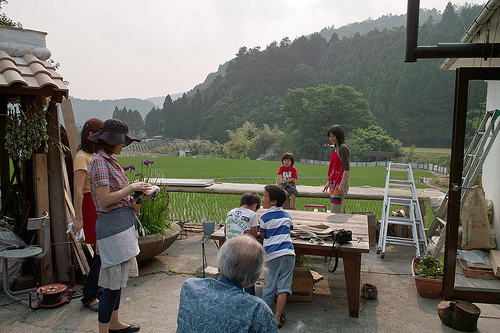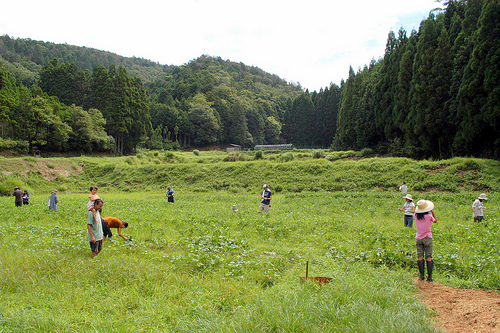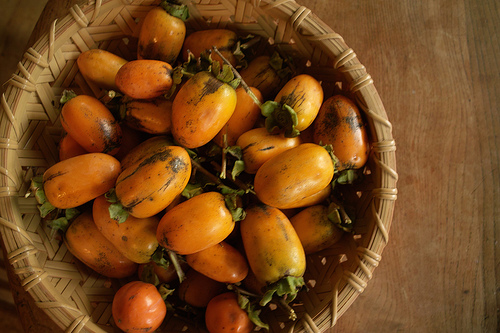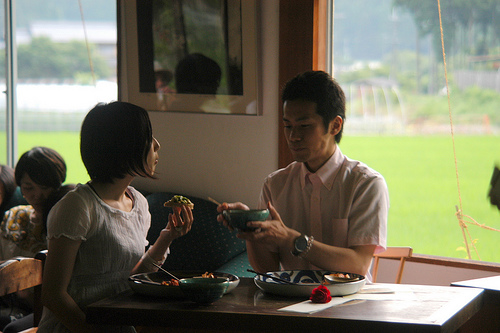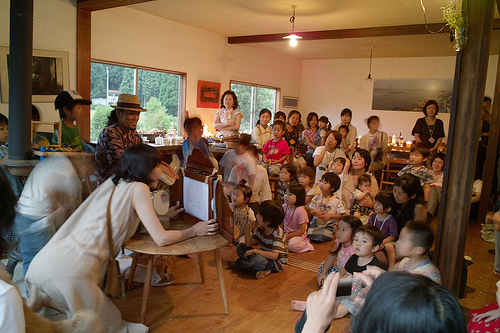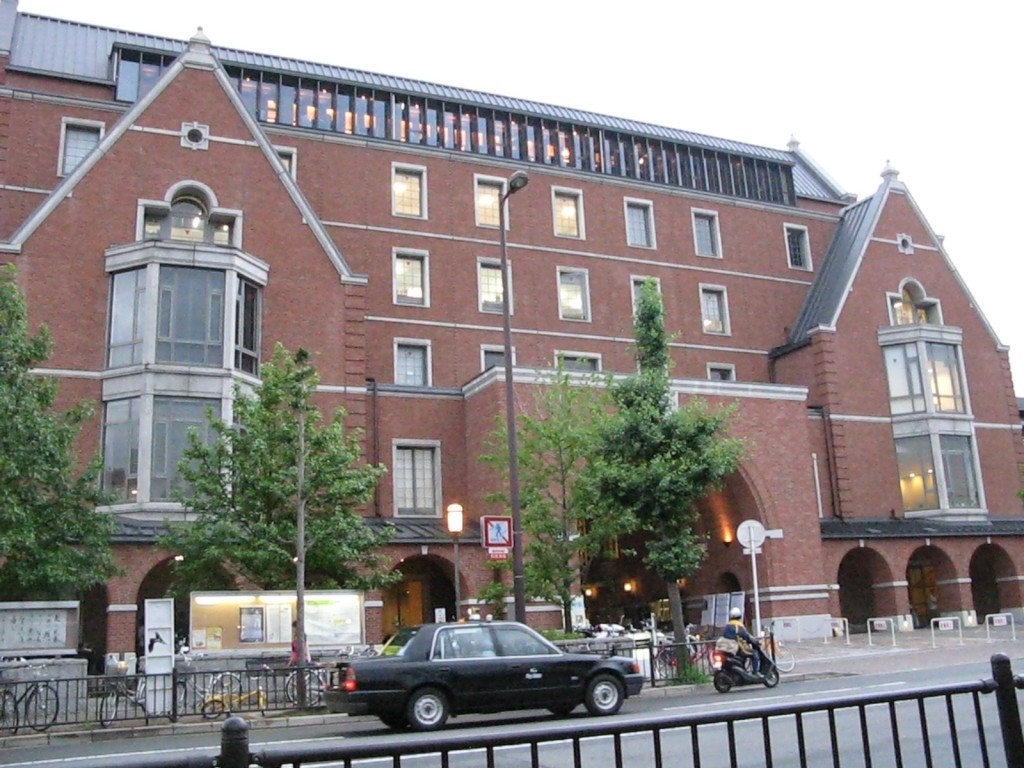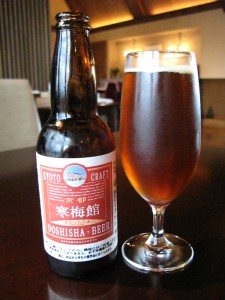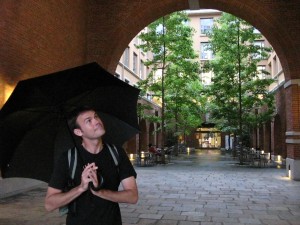http://www.deepkyoto.com/cafe-millet/
"Ted Taylor writes…
On a warm autumn afternoon, during a north Kyoto hike from Ohara over
to Kurama, we came across a group of young people building a wood
burning oven out of stone. Standing in front of this ishigama, we made
small talk with the young couple in charge of the project. The young
woman told us that the bread that this oven would bake would be a
centerpiece of the cafe that had just opened here, her hand gesturing at
a comfortable looking building made of wood and glass. We promised to
come back again.
A month or so later we ran into them again in Ohara, this time as part of a larger group busy harvesting adzuki and soy, some of which would wind up that night on the table of Cafe Millet.
What at first seems like a throwback scene to the old hippie days is
actually a large and growing trend in Japan. Driven by both
environmental and economic concerns, many young Japanese are shunning a
life in the cities for one in the soil.
The idea of returning to the countryside is hardly a new one. Masanobu Fukuoka’s classic work, “The One-Straw Revolution” has for over 30 years lured people back to a traditional life of farming. What is different this time is that the movement is not simply at the personal or grass roots level. In March of this year, Prime Minister Taro Aso created the Rural Labor Squad, as a way to give employment to the young while simultaneously revitalizing rural communities and their dwindling labor pool. Local farmers are for the most part grateful for the help, though some feel that the young will once again return to the city when the economy picks up.
While some people are able to make this I-turn to the countryside, others are taking on the more modest task of planting crops atop buildings in some of Japan’s urban centers. The focus here is more environmental, with growing concerns about food safety after a recent chain of tainted food scandals. This movement too is encouraged by the municipal governments, as a means in which to lower the summer heat index, as temperatures soar due to an overabundance of heat-absorbing concrete and asphalt. This heat in turn increases air-conditioner use, leading to higher carbon emissions. As a previous generation had found inspiration in Fukuoka’s book, these current farmers (both in the city and the country) have found a spokesman in Naoki Shiomi, with his series of books espousing a practical life style of “Half-Farmer and Half-X.”
For Juri Sumioka, Cafe Millet’s owner, the transition was no real transition at all. “When I was a kid, I used to enjoy making things with my friends. Since high school, I’ve had more opportunity to cook for people. It was only natural that I’d open a cafe.” Her husband Atsushi agrees that it had come naturally. “I one day noticed that I’d already been living this way. I was into growing food long before I was into cooking. Growing rice led me to an interest in growing wheat. That led of course to my bread making.”
The organic food movement in Japan is by no means new. The current interest originated a decade ago with middle aged women who, watching many men of their generation succumb to cancer and heart disease, began to take a greater interest in the source of their food. What makes Cafe Millet special is that everything served is grown in the surrounding fields and gardens. This has greater benefits than simple delicious ingredients. “I feel great happiness in reaping the blessings of a life lived naturally, and not being occupied with doing business but instead, simply living. Around food we can create a community out of all sorts of people, of any age or occupation,” Juri says. “With money, we can quickly accomplish just about anything. But I find much more value in time spent in the present, with family and neighbors. Plus being able to live according to the rhythms of nature, amidst food growing all around you, it is easy to pass the time in an valuable way.”
On her philosophy of cooking: “We hope that people who come to eat here feel that our food is similar to their own mother’s cooking, and find that ‘The heart of all is connected by food,’ which is our motto, of sorts” She adds, “People also can feel that we put our hearts into producing the ingredients. Even with so called high cuisine that uses very expensive ingredients, if it was prepared without love and care, it doesn’t resonate in the soul. Eating is a natural act for animals and people, but I think that it has a very important role in the formation of our body and spirit.”
Working together as a couple has many benefits. While Juri is responsible for what appears on the table, Atsushi provides the materials. “How vegetables are grown is important, of course, but the fact that they are organic vegetables made without pesticides is not the only important information. We also need to consider the manner in which they are sold, the environment where the vegetables grow, the methods of the farmers. We must ask questions like, ‘What nutrients are there?’ ‘What is most effective?’ ‘Where was it produced?’ ‘At what cost?’ And for us, the most important question is, “Does the food have soul?”
His own approach to agriculture borders on the spiritual. “Vegetables and grains have a characteristic flavour and shape. Yet beyond the shape, we ask ‘Is there ki?’, ‘Is there consciousness?’ You can easily see this from the state of the produce. There are veggies that are entirely eaten by insects, and some that aren’t at all. If you take a look, you can see that those not eaten by bugs are vibrant and brimming with vitality. Those that are partially eaten are limp and weak. It’s the same as how when our immunity and energy are weak, we slip into disease. All produce is made from sun, water, earth, and human labor. It reflects the environment in which it was made. Science can give insight into proteins, carbohydrates and the composition of food, but the form a vegetable takes is determined only by its molecular structure. Vegetables are nourished by sun, energized by the power of innumerable microorganisms, and take form by the farmer’s labour. Eating the vegetable makes us one with the place.”
The quality of food served isn’t the only thing soulful about a meal at Cafe Millet. You dine in an airy room full of natural light, surrounded by photographs and implements of a country lifestyle, many no longer used and relegated to the status of ‘antique.’ The kitchen, visible from the table, is spacious and open, all stone and wood like the kitchens of southern Europe. There is a great sense of peace in the cafe’s location too. It is located at the head of the Shizuhara valley, with views across rice paddies stretching away to the mountains that mark the border of Kurama. “When we have our meals, we can feel the wind come down from the mountains and across the fields, and see the next generation of ingredients from the window. This helps us to enjoy the food more. It is part of the food’s essence,” Juri explains.
The cafe also has regular events, mostly based around the theme, “Agriculture and Food.” These events usually take shape as vegetarian cooking classes, yoga workshops, and live music sessions, events that are always stimulating and inspiring.
“Shizuhara is located between the sightseeing centers of Ohara and Kurama, but actually there is very little to see here, tourist-wise. Seemingly there is nothing, but there is quiet, and the slow passing of time. We try to plan events and projects by thinking about making the best use of this environment as we can.” Atsushi adds, “We think it is important to experience things for yourself. By hosting workshops, we can continue to pursue things we enjoy. I think that if we actively pursue those things that greatly interest us, we can easily have the type of life that we desire.’
He feels that this is one of the catalysts for the recent migration of young people. “Many people these days don’t have any drive or ambition, and are lost as how to live. But by simply living in the present, in following their bliss, they’ll eventually find their own way to live.” Juri too feels it important to continue chasing what you like. “You’ll meet people and have experiences that you’d never expected.”
Atsushi feels that “there is growing doubt in the lifestyle of cities, living in apartment houses where you can’t see the ground, doubt in the ideas of our parents’ generation with its mass production and mindless consumption. They are beginning to seek life in a natural, rich environment. These young people are attracted to the idea of working with the soil in heavy labor. The number who relocate to the countryside and assume organic farming as work has increased every year.” Juri adds, “I truly believe we are in an age of change, and more and more people will actively seek a new lifestyle.”
And on their own changes, what are their more long-term plans for Cafe Millet?
“We are in the process of building a tree house in the big zelkova tree
down by the stream. Later, we hope to keep a donkey nearby. In the old
days of Kyoto, people used to sell bread from donkey-drawn carts that
would circle throughout the city. We are toying with the idea of
starting that up again. In addition, many people are beginning to
bring their kids to Millet, and it is becoming something of a natural
daycare center. I want it to be a place where kids can come learn and
play. An environment where people can raise food and be around animals.
And meet the local people, who also can benefit from this exchange.”
Juri says, “Most of our inspiration comes from people, from friends and the older farmers in this village. The traditions of this region shaped its vegetables and in eating them it makes us part of this place. Since we can never predict the ways of nature, we never know how a harvest will turn out. There is always great excitement at seeing the bounty we get.”
A sample of this bounty is available by reservation only. Call 075-741-3303
For directions and workshop information check their website (Japanese only). Here is a map.
Text by Ted Taylor.
Pictures courtesy of Cafe Millet."
On the turntable: U2, "Songs of Innocence"



